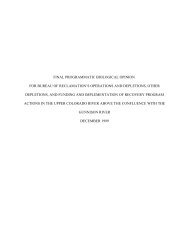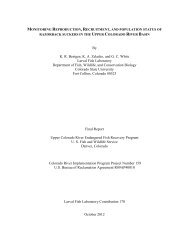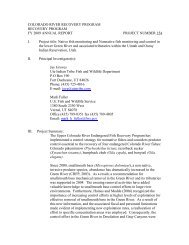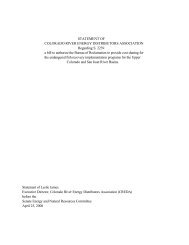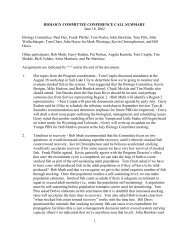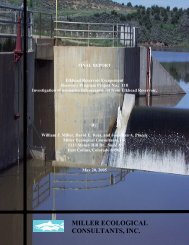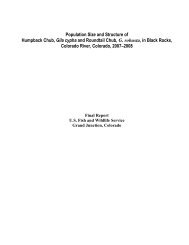riprap - Upper Colorado River Endangered Fish Recovery Program
riprap - Upper Colorado River Endangered Fish Recovery Program
riprap - Upper Colorado River Endangered Fish Recovery Program
Create successful ePaper yourself
Turn your PDF publications into a flip-book with our unique Google optimized e-Paper software.
To restore floodplain habitats, levees have been breached at 3 sites (46 acres) and tenproperties acquired in perpetual easement or fee title to protect 394 acres.Active management of smallmouth bass began in 2004. Largemouth bass also aretargeted, but fish >10” in length originally were to be translocated to Highline Lake.Prior to the 2011 sampling season, the <strong>Recovery</strong> <strong>Program</strong> recommended and CDOWagreed to cease translocation of largemouth bass. Operation of the fish barrier net atHighline Reservoir has been ongoing since 1999; the net was replaced in March 2006and is scheduled for replacement in 2012. A CSU/CDOW study to determine thesource of centrarchid fishes suggested that floodplain pond contributions to riverinenonnative fish populations fluctuate with the interannual variations in flow regime andriver–pond connectivity (Whitledge et al. 2007).Razorback sucker and bonytail are being stocked in the <strong>Colorado</strong> <strong>River</strong> in accordancewith the integrated stocking plan (Nesler et al. 2003).3.6 GUNNISON RIVER3.6.1 ImportanceThe Gunnison <strong>River</strong> is currently occupied by wild <strong>Colorado</strong> pikeminnow and is historichabitat for razorback sucker and presumably bonytail. Several adult <strong>Colorado</strong>pikeminnow were captured in the Gunnison <strong>River</strong> in fishery surveys conducted in 1992and 1993. Unrestricted migration of fish has been limited by the 10-foot high Redlandsdiversion dam located 2 miles upstream from the mouth of the Gunnison <strong>River</strong>. Several<strong>Colorado</strong> pikeminnow larvae have been collected in the Gunnison <strong>River</strong> upstream anddownstream of the Redlands diversion dam. Kidd (1977) reported that adult razorbacksucker were collected frequently by commercial fishermen near Delta, <strong>Colorado</strong>,between 1930 and 1950. Razorback sucker larvae were recently collected in theGunnison <strong>River</strong> (Osmundson and Seal 2009), and the reach near Delta is considered apriority razorback sucker restoration site. The native fish assemblage in the Gunnison<strong>River</strong> is presently less impacted, compared to other rivers, by nonnative fishes(particularly piscivorous species), and management efforts should emphasizepreserving this feature of the river.3.6.2 <strong>Recovery</strong> Actions<strong>Recovery</strong> activities on the Gunnison <strong>River</strong> are focused on operating and evaluating afish ladder at the Redlands diversion dam, reoperating the Aspinall Unit to improveflow/habitat conditions in the Gunnison <strong>River</strong>, and restoring flooded bottomland habitatsnear Delta. Perpetual easements have been acquired on three properties (198 acres).Construction of a fish ladder at the Redlands diversion dam was completed in 1996 andhas provided for passage of <strong>Colorado</strong> pikeminnow, razorback sucker, and other nativefishes (as well as allowing exclusion of nonnative fishes). In 2010, the first humpback23



